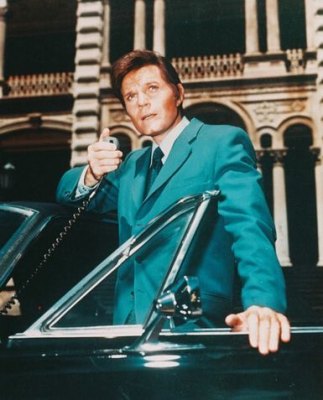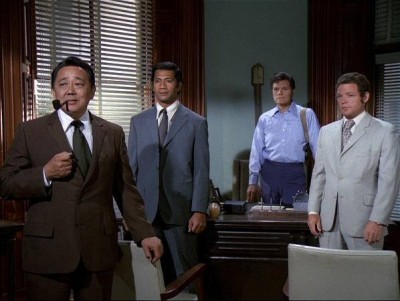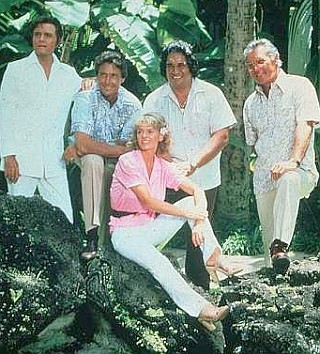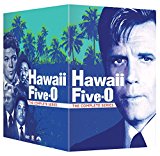| Reviews & Columns |
|
Reviews DVD TV on DVD Blu-ray 4K UHD International DVDs In Theaters Reviews by Studio Video Games Features Collector Series DVDs Easter Egg Database Interviews DVD Talk Radio Feature Articles Columns Anime Talk DVD Savant Horror DVDs The M.O.D. Squad Art House HD Talk Silent DVD
|
DVD Talk Forum |
|
|
| Resources |
|
DVD Price Search Customer Service #'s RCE Info Links |
|
Columns
|
|
|
Hawaii Five-O: The Complete Series
CBS-Paramount released the original Five-O's entire run, 12 seasons, between 2007-2012, with each season originally retailing for $50 a pop. A complete series boxed set was released a few years ago, but this is yet another, even less expensive repackaging, retailing for $179.98 but as I write this currently selling on Amazon for $99.02. Not only is that a discount of about 84% off what the original seasons sets sold for, it comes out to around 35 cents per episode.
Compared with similar shows of its era, Hawaii Five-O was more adult, more political, and certainly more violent. It was both a police procedural cop/detective show dealing with local crime, but frequently its scripts also veered into international espionage territory. As it proudly boasted in its end credits (excepting a couple of episodes), Hawaii Five-O was filmed entirely on location in Hawaii - no backlot streets or rear-screen beaches for this show. Despite this, from the beginning the series contrasted the tropical paradise of hula dancers and luaus enjoyed by mainland and foreign tourists with the poverty of islanders, native Hawaiians especially. The series may nearly be 50 years old but, Jack Lord's trademark triple-black 1968 Mercury Park Lane Brougham aside, on DVD it looks almost brand-new.
Its name derived from Hawaii's status as our 50th state, Five-O is a fictional state police agency headed by former Navy officer Steve McGarrett (Jack Lord), answerable only to Governor Paul Jameson ('50s sci-fi star Richard Denning). Working with both local authorities and "intelligence" (the CIA, unnamed), McGarrett is aided by detectives Danny "Danno" Williams (James MacArthur), Chinese-American Chin Ho Kelly (Kam Fong, a real former Hawaii police officer-turned-actor) and native Hawaiian Kono Kalakaua (Zulu).
In the 96-minute pilot, "Cocoon," the series established how this state-run organization and its geographical position in the Pacific provides a crucial assist to national intelligence - and this first episode established its most popular recurring villain, special Red Chinese agent Wo Fat. Played with articulate amusement by Khigh Dhiegh, the character was inspired if derivative: Dhiegh in all but name was reprising his character from John Frankenheimer's superb adaptation of Richard Condon's The Manchurian Candidate (1962).
With a few minor missteps, "Cocoon" established everything that was great about Hawaii Five-O. The intelligent, methodical nature of Steve McGarrett's investigations, his demanding leadership (he expects nothing less than the best from his hard-working staff), a willingness to lock horns with other agencies, suspects, etc. that impede his job and authority, and a wry, understated amusement when his unpredictable actions infuriate those working against him. (One early show, for instance, has McGarrett on the beach listening to Phillip Pine's annoyed attorney complain about his independently-minded client. McGarrett listens patiently then casually gets in his car and drives off, leaving the lawyer stranded.) Throughout the series McGarrett remained somewhat enigmatic, but intriguing little references about his past and personality quirks slip through here and there.
(The pilot includes an extended version of the series iconic opening titles**, and features different actors playing Danny and the Governor. Danny in this show only is played by Tim O'Kelly, the sniper from Targets, with Lew Ayres guest-starring as the Governor.)
MacArthur's Danny is more emotional and impulsive, with understandably human concerns McGarrett has to reign in to keep him focused on the job at hand. Chin Ho and Kono not only add local color - their very naturalistic performances are eminently likable and engaging, and help give the show a humanism that fit well with McGarrett's hard-edged chief. The show was a boon for Asian and Hawaiian actors, and Kam Fong and Zulu in particular did much to eradiate the racial stereotyping of earlier films and TV shows, just as the show painted a more realistic portrait of the popular vacation destination. Among the Asian actors in guest spots this first year: Nancy Kwan, Philip Ahn, James Shigeta, and Soon-Tek Oh.
The creation of Leonard Freeman, Hawaii Five-O doesn't play down to its audience like most '60s and '70s cop shows; though not exactly intellectual, Hawaii Five-O was a show for grown-ups. It was surely one of the most violent shows of its day. Characters bleed when shot: the pilot has McGarrett shoot an attacker three times at point blank range, and an early episode ("Strangers in Our Own Land") opens with a still-shocking car bomb explosion. The show also impressively deals with the love-hate relationship native Hawaiians have with white American developers: that the bustling tourist trade comes at a heavy price, namely the raping of the land and a certain loss of identity for its indigenous people.
Indeed, while Hawaii Five-O's scripts dealt with the usual crimes associated with cop shows, most episodes do so within the particular context of Hawaii's unique status geographically, of its international and culturally diverse makeup.
In Year Two the show's characters are further refined, with credibility strained somewhat by having McGarrett at the center of the action most of the time: in "Savage Sunday" he catches Silva's revolutionary off-guard by shimmying down a rope through a broken skylight, drawing fire from his opponent's M-16. Beyond the fact that there's no base security anywhere in sight, this kind of thing - aren't there more qualified men to do that job? - while in keeping with the standards of late-'60s TV shows and their leading men, is still pretty hard to swallow. Nevertheless, Lord's intense performances are eminently watchable; it's clear why he's the star of the show.
MacArthur's Danny, less experienced and more impulsive and emotional in the first season, wisely has been matured into a thorough professional, while Zulu's Kono gets to keep his enjoyably casual air and Kam Fong's Chin Ho Kelley his paternal one. Former Universal contract player Peggy Moran began her long run on the series this season as Millie, the governor's secretary.
Adhering to this formula means shows like Hawaii Five-O rise and fall on the quality of their teleplays and the charisma of the actors to carry viewers through weaker episodes. Lord's enigmatic workaholic McGarrett is a fascinating character, but only rarely do episodes scratch below the surface, such as in the first season two-parter, "Once Upon a Time." In the third season, Danny gets a girlfriend (Anne Archer!) only to have her murdered by an apparent serial killer. We hear nothing about her before or after this (at least not that this reviewer is aware of) and while the show's a good one, it's a good example of the limitations of so many programs of the era. On the other hand, if Hawaii Five-O does indeed rise and fall on the basis of its scripts, then its third season (1970-71) is a generally strong and varied one, quality-wise pretty much on the level of the previous two years.
Around the end of the fourth year, Zulu (born Gilbert Lani Kauhi) got into a fight with the show's publicist; reportedly Zulu used racial slurs during the incident, and the actor was fired. For his part, Zulu said at the time, "I need something different. I've had it with the 'Yes boss, no boss' routine." He had a point. Hawaii Five-O unequivocally was Jack Lord's show; the supporting cast did just that, support its star. This was apparently true behind-the-scenes as well; he had a reputation as something of an imperious martinet on the set, with some affectionately/derisively calling him "The Lord" behind his back.
Likeable or not, Jack Lord's Steve McGarrett was a great character: intense, curt, unrelenting, caustic, consumed by his job and demanding the same dedication from his staff. Maybe the Actor's Studio-trained Lord was merely staying in character, living the role all those years.
Fourth season shows exhibit a real confidence in the material by the cast and crew, and the series' huge popularity is now apparent in some of the location work. During the first season nobody paid much attention to Lord, MacArthur and the crew, but here you'll often see throngs of vacationers gawking at the stars from a distance.
Zulu's absence was keenly felt, however. He was big and tough like a sumo wrestler but also rather cuddly. He added a strong native Hawaiian flavor to the series, and his blue-collar wit and unassuming nature were major assets to the show, especially in how Kono contrasted McGarrett's no-nonsense approach.
Zulu was replaced by Al Harrington (born Tausau Ta'a, in Pago Pago) as Polynesian Detective Ben Kokua; Harrington had played other characters in five earlier episodes. In early fifth season shows he doesn't have a lot to do, partly because for season five the series really ramped up the presence of other supporting, continuing characters. Besides Jenny, Five-O's secretary, and medical examiner Che Fong (Harry Endo), other continuing characters include Honolulu Police Department Sgt. Edward "Duke" Lukela (Heman Wedemeyer), Doc Bergman (Al Eben), and District Attorney John Manicote (Glenn Cannon).
Zulu's departure also necessitated new opening titles, these probably the most iconic of Five-O's long run. MacArthur now peers through the broken glass of an upturned car (from a fourth season episode) while Chin Ho, formerly in a staged shot identical to McGarrett's, is seen on a rooftop with a walkie-talkie. Gone too is Hawaii Five-O's pre-title prologue sequence. Maybe they wanted the show's famous theme and title design up-front to grab viewers, but I miss the anticipation leading up to it in seasons 1-4.
Jack Lord's sanctimonious, all-work/no-play McGarrett (it's too bad he never crossed paths with workaholic Joe Friday) unquestionably is the star of the show, a status furthered by the oddest of reminders: in the sixth season his name reappears over the end credits - "Hawaii Five-O, Starring Jack Lord" - along with the episodes guest stars, but not MacArthur, Fong, or Harrington. McGarrett remains one of television's coolest cats - he's to '70s police procedurals what Sean Connery was to '60s spy films - and yet as the series went on, Lord stubbornly refused to age gracefully. In an effort to look the same in 1980 as he did in 1968 he tends to look increasingly unreal and waxy.
The Sixth Season is notable for stretching a bit, teleplays-wise. The offbeat nature of the scripts is established in the first episodes of the season. "Hookman," the season-opener, is one of the best episodes of the entire series. The audacious opening is brilliant: an armless serial sniper (real-life armless celebrity detective Jay J. Armes), using a refitted rifle and hooks for hands, kills a motorcycle cop escorting a funeral procession - pandemonium erupts and the casket flies out of the hearse during the melee. The many scenes of the sniper ingeniously using his hooks preparing for the next hit are played without any dialogue; everything is told visually, adding enormously to the suspense and fascination with this unusual story.
Hawaii Five-O stayed strong through about the ninth season, and for several seasons even opened with lavish, 90-minute season openers with even more lavish production values. Also by this time, the series was attracting the biggest stars, partly due to the show's established ratings success, but no doubt also because guesting on Five-O facilitated a free trip to Hawaii.
It's last two seasons, however, saw the program in clear decline. By season eleven, McGarrett was like a king without a kingdom. Zulu's Kono was by this time a distant memory. Kam Fong's Chin Ho Kelly, a critically important supporting character, was killed off at the end of season ten, while season eleven turned out to be James MacArthur's last. Apparently, while on vacation in South America, MacArthur simply called his agent and said, "I'm done." He never came back. Duke Lukela, former cop, tried to fill the vacuum, but there were just too many big shoes to fill.
Season Twelve, sporting a more pulsating if not outright disco-ized and reorchestrated title theme, starts promisingly, introducing three new supporting players. Moe Keale's Det. "Truck" Kealoha was little more than a Kono clone, but he was also a native Hawaiian, helping to keep the series' make-up racially integrated. More importantly, William Smith (as Det. James "Kimo" Carew) and Sharon Farrell (as Det. Lori Smith) each brought something new. Gravelly-voiced, muscular Smith, better known for playing badass bikers and the like (bare-knuckling it with Clint Eastwood in one film, believably playing Arnold Schwarzenegger's super-strong father in another), makes a stark contrast to sensitive good guy Danny Williams. Smith looks like he could pound you into the ground like a tent stake. Carew is introduced in the season opener as a vengeful Boston cop in Hawaii tracking down the man who murdered his wife and child.
Farrell, meanwhile, turns up in the second episode, which rather unimaginatively has her playing a similarly vengeful Hawaii-based cop tracking down the men who murdered her police detective husband - on their anniversary and the day he was supposed to start his new job at Five-O. McGarrett ultimately invites Lori to take his place, which is mighty considerate considering she comes within an inch of murdering her husband's killer in cold blood. Farrell, always good playing distraught characters (see It's Alive, her pièce de résistance) has decent chemistry with Smith, their characters' similar tragedies providing a unique bond.
Alas, it's all for naught. By mid-season the waters are muddied with one terrible episode after another, shows like "Voice of Terror," "School for Assassins," and especially "A Bird in the Hand," which Quigley identifies as the all-time worst of Five-O's nearly 300 episodes.
The twelfth season shows never cracked the Top 30 in the ratings, and the writing was on the wall. Farrell, quite in demand at this time, left mid-season and appears in less than half the season's shows. Lord and the show's producers, perhaps realizing the end was near, assembled something like a final episode, "Woe to Wo Fat," intended as a final confrontation between McGarrett and his Moriaty, super villain Wo Fat.
McGarrett goes undercover, masquerading as esteemed scientist Elton Raintree (Lord plays the real Raintree as well). With his old professor makeup, Lord is a dead ringer for Billy Connolly. He also looks a lot like Steve McGarrett in a disguise worthy of Inspector Clouseau. Why doesn't Wo Fat recognize him at once? It's a show as tired as its leads; Lord was pushing 60, and Dhiegh was 70 and both look it. Lord with his singularly hairy hands and artificially thickened hairstyle, and Dhiegh, with his shaved head but sporting impressively bushy ear hair, make this an episode sufferers of chaetophobia will want to avoid. Still it's good to see the series have some closure, even if its final image is of Wo Fat wearing outrageously anachronistic striped prison garb, the kind that went out with two-reel comedies.
The end of Hawaii Five-O was, sadly, pretty much the end of star Jack Lord as well. His only post-Five-O appearance was a small part in a TV movie/pilot he produced and directed, M Station: Hawaii (1980), but while that aired in the summer after Five-O was cancelled, it was actually filmed before the start of season twelve. During the regular season, the already infamously combative actor was even more short-tempered than usual, and according to some that were there, already exhibiting the early signs of Alzheimer's Disease. After Hawaii Five-O finished production, Lord went into seclusion and all but vanished. He died in 1998, apparently years after his personality had succumbed to the illness.
Video & Audio
Hawaii Five-O - The Complete Series utilizes the same DVD pressings as the original season sets. They look great. The image is sharp and detailed, near flawless, and on five single-sided, dual-layered DVDs. The Dolby Digital mono is fine, as are the optional English subtitles, with earlier seasons offering Spanish audio tracks and Spanish and Brazilian Portuguese subtitles.
The packaging is compact but that's where the advantages end. The box holding three big DVD cases, each containing four seasons, is flimsy, and gone are episode descriptions and other info included on the season sets. Here, there are episode titles only, which isn't exactly helpful when you want to locate a particular show. For the record, "The Complete Series" isn't entirely accurate. As before, the season 2 episode "Bored, She Hung Herself" is not included, that episode having been pulled from circulation since its one-time airing in 1970
Extra Features
Supplements are limited mainly to episodic promos. The first season set includes Emme's Island Moments: Memories of "Hawaii Five-O", an apparently expanded "special edition" version of a 1996 program originally produced for Hawaiian television. Hosted by Emme Tomombong, the show belies it local origins, holding up extraordinarily well and features an impressive array of behind-the-scenes footage, then-and-now location material, and interviews with surviving cast and crew members, as well as local columnists and government types who talk about the show's local impact. It's a treasure trove of good information, and fans of the shows will be pleased.
Parting Thoughts
If you've been holding off buying Hawaii Five-O because of the price of those season sets, now's the time. Highly Recommended.
Special thanks to Hawaii Five-O fan Howard S. Sample, whose comments and enthusiasm enhanced this review.
Stuart Galbraith IV is the Kyoto-based film historian largely absent from reviewing these days while he restores a 200-year-old Japanese farmhouse.
|
| Popular Reviews |
| Sponsored Links |
|
|
| Sponsored Links |
|
|
| Release List | Reviews | Shop | Newsletter | Forum | DVD Giveaways | Blu-Ray | Advertise |
|
Copyright 2024 DVDTalk.com All Rights Reserved. Legal Info, Privacy Policy, Terms of Use,
Manage Preferences,
Your Privacy Choices | |||||||

















